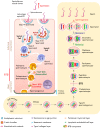Germ cell transport across the seminiferous epithelium during spermatogenesis
- PMID: 24985332
- PMCID: PMC4103058
- DOI: 10.1152/physiol.00001.2014
Germ cell transport across the seminiferous epithelium during spermatogenesis
Abstract
Transport of germ cells across the seminiferous epithelium is crucial to spermatogenesis. Its disruption causes infertility. Signaling molecules, such as focal adhesion kinase, c-Yes, c-Src, and intercellular adhesion molecules 1 and 2, are involved in these events by regulating actin-based cytoskeleton via their action on actin-regulating proteins, endocytic vesicle-mediated protein trafficking, and adhesion protein complexes. We critically evaluate these findings and provide a hypothetical framework that regulates these events.
©2014 Int. Union Physiol. Sci./Am. Physiol. Soc.
Conflict of interest statement
No conflicts of interest, financial or otherwise, are declared by the author(s).
Figures




Similar articles
-
Polarity proteins and actin regulatory proteins are unlikely partners that regulate cell adhesion in the seminiferous epithelium during spermatogenesis.Histol Histopathol. 2011 Nov;26(11):1465-74. doi: 10.14670/HH-26.1465. Histol Histopathol. 2011. PMID: 21938683 Free PMC article. Review.
-
Extracellular matrix: recent advances on its role in junction dynamics in the seminiferous epithelium during spermatogenesis.Biol Reprod. 2004 Aug;71(2):375-91. doi: 10.1095/biolreprod.104.028225. Epub 2004 Apr 28. Biol Reprod. 2004. PMID: 15115723 Review.
-
Transport of germ cells across the seminiferous epithelium during spermatogenesis-the involvement of both actin- and microtubule-based cytoskeletons.Tissue Barriers. 2016 Nov 28;4(4):e1265042. doi: 10.1080/21688370.2016.1265042. eCollection 2016. Tissue Barriers. 2016. PMID: 28123928 Free PMC article. Review.
-
Cytoskeletal dynamics and spermatogenesis.Philos Trans R Soc Lond B Biol Sci. 2010 May 27;365(1546):1581-92. doi: 10.1098/rstb.2009.0261. Philos Trans R Soc Lond B Biol Sci. 2010. PMID: 20403871 Free PMC article. Review.
-
Zyxin, axin, and Wiskott-Aldrich syndrome protein are adaptors that link the cadherin/catenin protein complex to the cytoskeleton at adherens junctions in the seminiferous epithelium of the rat testis.J Androl. 2004 Mar-Apr;25(2):200-15. doi: 10.1002/j.1939-4640.2004.tb02780.x. J Androl. 2004. PMID: 14760006
Cited by
-
Filamentous actin disorganization and absence of apical ectoplasmic specialization disassembly during spermiation upon interference with retinoid signaling†.Biol Reprod. 2020 Aug 4;103(2):378-389. doi: 10.1093/biolre/ioaa123. Biol Reprod. 2020. PMID: 32678439 Free PMC article.
-
Dynein 1 supports spermatid transport and spermiation during spermatogenesis in the rat testis.Am J Physiol Endocrinol Metab. 2018 Nov 1;315(5):E924-E948. doi: 10.1152/ajpendo.00114.2018. Epub 2018 Jul 17. Am J Physiol Endocrinol Metab. 2018. PMID: 30016153 Free PMC article.
-
Vangl2 regulates spermatid planar cell polarity through microtubule (MT)-based cytoskeleton in the rat testis.Cell Death Dis. 2018 Mar 1;9(3):340. doi: 10.1038/s41419-018-0339-x. Cell Death Dis. 2018. PMID: 29497043 Free PMC article.
-
RETRACTED ARTICLE: Copper Exposure Destroys the Integrity of the Blood-Testis Barrier (BTB) Through p38 MAPK-Meditated Autophagy Pathways.Biol Trace Elem Res. 2025 Jul;203(7):3987. doi: 10.1007/s12011-024-04449-1. Epub 2024 Nov 18. Biol Trace Elem Res. 2025. PMID: 39551859 Retracted. No abstract available.
-
Identification of novel cytoskeleton protein involved in spermatogenic cells and sertoli cells of non-obstructive azoospermia based on microarray and bioinformatics analysis.BMC Med Genomics. 2025 Jan 25;18(1):19. doi: 10.1186/s12920-025-02087-7. BMC Med Genomics. 2025. PMID: 39863862 Free PMC article.
References
-
- Amann RP. The cycle of the seminiferous epithelium in humans: a need to revisit? J Androl 29: 469–487, 2008 - PubMed
-
- Amann RP, Howards SS. Daily spermatozoal production and epididymal spermatozoal reserves of the human male. J Urol 124: 211–215, 1980 - PubMed
-
- Amann RP, Schanbacher BD. Physiology of male reproduction. J Anim Sci 57, Suppl 2: 380–403, 1983 - PubMed
-
- Auharek SA, Avelar GF, Lara NLM, Sharpe RM, Franca LR. Sertoli cell numbers and spermatogenic efficency are increased in inducible nitric oxide synthase (iNOS) mutant-mice. Int J Androl 34: e621–e629, 2011 - PubMed
Publication types
MeSH terms
Grants and funding
LinkOut - more resources
Full Text Sources
Other Literature Sources
Miscellaneous

